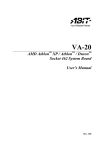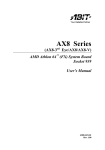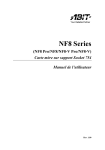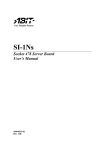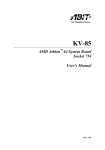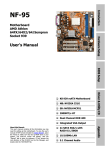Download Abit AMD Athlon 64 System Board Socket 754 User`s manual
Transcript
KV-80/KV-81/KV-82 AMD Athlon 64 System Board Socket 754 User’s Manual 4200-0426-01 Rev. 1.00 Copyright and Warranty Notice The information in this document is subject to change without notice and does not represent a commitment on part of the vendor, who assumes no liability or responsibility for any errors that may appear in this manual. No warranty or representation, either expressed or implied, is made with respect to the quality, accuracy or fitness for any particular part of this document. In no event shall the manufacturer be liable for direct, indirect, special, incidental or consequential damages arising from any defect or error in this manual or product. Product names appearing in this manual are for identification purpose only and trademarks and product names or brand names appearing in this document are the property of their respective owners. This document contains materials protected under International Copyright Laws. All rights reserved. No part of this manual may be reproduced, transmitted or transcribed without the expressed written permission of the manufacturer and authors of this manual. If you do not properly set the motherboard settings, causing the motherboard to malfunction or fail, we cannot guarantee any responsibility. KV-80/KV-81/KV-82 Table of Contents Chapter 1. 1-1. 1-2. Chapter 2. 2-1. 2-2. 2-3. 2-4. Hardware Setup.................................................................... 2-1 Install The Motherboard...........................................................................2-1 Install CPU and Heatsink.........................................................................2-2 Install System Memory ............................................................................2-3 Connectors, Headers and Switches ..........................................................2-4 (1). ATX Power Input Connectors........................................................2-4 (2). FAN Connectors.............................................................................2-5 (3). CMOS Memory Clearing Header ..................................................2-6 (4). Wake-up Header.............................................................................2-7 (5). Front Panel Switches & Indicators Headers ..................................2-8 (6). Additional IEEE1394 Port Headers (Optional for KV-80) ............2-9 (7). Additional USB Port Headers........................................................2-9 (8). Front Panel Audio Connection Header ........................................2-10 (9). Serial ATA Connectors .................................................................2-10 (10). Accelerated Graphics Port Slot ....................................................2-11 (11). Internal Audio Connectors ...........................................................2-11 (12). Floppy and IDE Disk Drive Connectors ......................................2-12 (13). Back Panel Connectors ................................................................2-13 Chapter 3. 3-1. 3-2. 3-3. 3-4. 3-5. 3-6. 3-7. 3-8. 3-9. 3-10. Introduction .......................................................................... 1-1 Features & Specifications ........................................................................1-1 Layout Diagram .......................................................................................1-3 BIOS Setup............................................................................ 3-1 SoftMenu Setup........................................................................................3-2 Standard CMOS Features.........................................................................3-3 Advanced BIOS Features.........................................................................3-5 Advanced Chipset Features......................................................................3-7 Integrated Peripherals ............................................................................3-10 Power Management Setup .....................................................................3-14 PnP/PCI Configurations.........................................................................3-17 PC Health Status ....................................................................................3-18 Load Fail-Safe Defaults .........................................................................3-19 Load Optimized Defaults .......................................................................3-19 User’s Manual 3-11. 3-12. 3-13. Set Password ..........................................................................................3-19 Save & Exit Setup ..................................................................................3-19 Exit Without Saving...............................................................................3-19 Chapter 4. 4-1. Driver Installation ................................................................ 4-1 Setup Items...............................................................................................4-2 Appendix A. KV-80/KV-81/KV-82 How to Get Technical Support ........................................................ A-1 Introduction 1-1 Chapter 1. Introduction 1-1. Features & Specifications 1. CPU • Supports AMD Socket 754 Athlon 64/Sempron Processor with 1600MHz Hyper-Transport • Supports AMD K8 CPU Cool ‘n’ Quiet Technology 2. CPU Integrated Memory Controller • 72-bit memory controller supports DDR at 266, 333 and 400MHz • Support 2 DIMM DDR400 up to 2GB Max 3. Chipset • VIA K8M800 + VT8237 4. Graphics • Integrated UniChrome Pro Graphics with 2D/3D/Video controller 5. SATA RAID • Serial ATA 1.5Gbps data transfer rate • Supports SATA RAID 0/1 6. LAN • Onboard 10/100/1000Mb (VIA VT6122 PCI Controller for KV-80/KV-81) • Onboard 10/100Mb (VIA VT6107 PCI Controller for KV-82) 7. IEEE 1394 • Supports 2 Ports IEEE 1394 at 100/200/400 Mb/s transfer rate (Optional for KV-80) 8. Audio • Onboard 6-channel Audio CODEC 9. ABIT Engineered • • • ABIT SoftMenu™ Technology ABIT FanEQ™ Technology CPU ThermalGuard™ Technology 10. Internal I/O Connectors • • • • • 1x AGP 8X/4X slot 2x PCI slots 1x Floppy port supports up to 2.88MB 2x Ultra DMA 133/100/66/33 connectors 2x Serial ATA 1.5Gbps connectors User’s Manual 1-2 Chapter 1 • • 2x USB 2.0 headers (Each header support two USB 2.0 devices) 1x CD-IN, 1x AUX-IN header • • 1x FP-Audio header 1x IEEE 1394 header (Optional for KV-80) 11. Back Panel I/O • • • • • 1x PS/2 keyboard, 1x PS/2 mouse 1x Parallel Port, 1x Serial Port, 1x VGA Port, 1x Audio connector (Line-out, Line-in, MIC) 4x USB 2.0, 1x RJ-45 LAN Connector 1x IEEE 1394 Connector (Optional for KV-80) 12. Miscellaneous • mATX form factor: 245 x 245 mm 13. Order Information Model Features KV-80 GbE LAN, IEEE1394 KV-81 GbE LAN KV-82 10/100M LAN Specifications and information contained herein are subject to change without notice. KV-80/KV-81/KV-82 Introduction 1-3 1-2. Layout Diagram User’s Manual 1-4 KV-80/KV-81/KV-82 Chapter 1 Hardware Setup 2-1 Chapter 2. Hardware Setup Before the Installation: Turn off the power supply switch (fully turn off the +5V standby power), or disconnect the power cord before installing or unplugging any connectors or add-on cards. Failing to do so may cause the motherboard components or add-on cards to malfunction or damaged. 2-1. Install The Motherboard Most computer chassis have a base with many mounting holes to allow motherboard to be securely attached on and at the same time, prevented from short circuits. There are two ways to attach the motherboard to the chassis base: 1. use with studs 2. or use with spacers In principle, the best way to attach the board is to use with studs. Only if you are unable to do this should you attach the board with spacers. Line up the holes on the board with the mounting holes on the chassis. If the holes line up and there are screw holes, you can attach the board with studs. If the holes line up and there are only slots, you can only attach with spacers. Take the tip of the spacers and insert them into the slots. After doing this to all the slots, you can slide the board into position aligned with slots. After the board has been positioned, check to make sure everything is OK before putting the chassis back on. ATTENTION: To prevent shorting the PCB circuit, please REMOVE the metal studs or spacers if they are already fastened on the chassis base and are without mounting-holes on the motherboard to align with. User’s Manual 2-2 Chapter 2 2-2. Install CPU and Heatsink This motherboard provides a ZIF (Zero Insertion Force) Socket 754 to install AMD Socket 754 CPU. The CPU you bought should contain with a kit of heatsink, cooling fan, retention frame and blackplate. If that’s not the case, buy one specially designed for Socket 754. Please refer to the figure shown here to install CPU and heatsink. (For reference only. Your Heatsink & Fan Assembly may not be exactly the same as this one.) 1. Locate the Socket 754 on this motherboard. Pull the CPU release lever sideways to unlatch and then raise it all the way up. 2. Drop the processor with its pin side down into the CPU socket. Do not use extra force to insert CPU; it only fits in one direction. Close the CPU release lever. 3. Align the Backplate Standoffs with the mounting holes on motherboard. Position the backplate onto motherboard. 4. Place the Retention Frame onto the motherboard and align it with the Backplate Standoffs. 5. Place heatsink on top of CPU, and make sure the heatsink fits properly on the retention frame. 6. Hook both sides of the Spring Clip onto the Mounting Tabs of Retention Frame. Tighten screws until the Spring Clip is fully installed. 7. Attach the fan connector of Heatsink & Fan Assembly with the CPU-FAN connector on the motherboard. ATTENTION: Do not forget to set the correct bus frequency and multiple for your processor. KV-80/KV-81/KV-82 Hardware Setup 2-3 2-3. Install System Memory This system board provides two 184-pin DDR DIMM slots for DDR400 memory modules with memory expansion size up to 2GB. Bank Memory Module Total Memory Bank 0, 1 (DIMM1) 256MB, 512MB, 1GB 256MB ~ 1GB Bank 2, 3 (DIMM2) 256MB, 512MB, 1GB 256MB ~ 1GB Total System Memory 256MB ~ 2GB NOTE: Usually there is no hardware or BIOS setup require after adding or removing memory modules, but you will have to clear the CMOS memory first if any memory module related problem occurs. Power off the computer and unplug the AC power cord before installing or removing memory modules. 1. Locate the DIMM slot on the board. 2. Hold two edges of the DIMM module carefully, keep away of touching its connectors. 3. Align the notch key on the module with the rib on the slot. 4. Firmly press the module into the slots until the ejector tabs at both sides of the slot automatically snaps into the mounting notch. Do not force the DIMM module in with extra force as the DIMM module only fit in one direction. 5. To remove the DIMM modules, push the two ejector tabs on the slot outward simultaneously, and then pull out the DIMM module. ATTENTION: Static electricity can damage the electronic components of the computer or optional boards. Before starting these procedures, ensure that you are discharged of static electricity by touching a grounded metal object briefly. User’s Manual 2-4 Chapter 2 2-4. Connectors, Headers and Switches Here we will show you all of the connectors, headers and switches, and how to connect them. Please read the entire section for necessary information before attempting to finish all the hardware installation inside the computer chassis. A complete enlarged layout diagram is shown in Chapter 1 for all the position of connectors and headers on the board that you may refer to. WARNING: Always power off the computer and unplug the AC power cord before adding or removing any peripheral or component. Failing to so may cause severe damage to your motherboard and/or peripherals. Plug in the AC power cord only after you have carefully checked everything. (1). ATX Power Input Connectors This motherboard provides two power connectors to connect to an ATX12V power supply. NOTE: It is recommended to connect to a power supply with 350W, 20A +5VDC capacity at least for heavily loaded system, and 2A +5VSB capacity at least for supporting wake-up features. KV-80/KV-81/KV-82 Hardware Setup 2-5 (2). FAN Connectors These 3-pin connectors each provide power to the cooling fans installed in your system. The CPU must be kept cool by using a powerful fan with heatsink. The system is capable of monitoring the speed of the CPU fan. • CPUFAN1: CPU Fan Power Connector • NBFAN1: Chipset Fan Power Connector • SYSFAN1: System Fan Power Connector WARNING: These fan connectors are not jumpers. DO NOT place jumper caps on these connectors. User’s Manual 2-6 Chapter 2 (3). CMOS Memory Clearing Header This header uses a jumper cap to clear the CMOS memory. • Pin 1-2 shorted (default): Normal operation. • Pin 2-3 shorted: Clear CMOS memory. WARNING: Turn the power off first (including the +5V standby power) before clearing the CMOS memory. Failing to do so may cause your system to work abnormally or malfunction. KV-80/KV-81/KV-82 Hardware Setup 2-7 (4). Wake-up Header These headers use a jumper cap to enable/disable the wake-up function. • PS2-PWR1: Pin 1-2 shorted (default): Disable wake-up function support at Keyboard/Mouse port. Pin 2-3 shorted: Enable wake-up function support at Keyboard/Mouse port • USB-PWR1: Pin 1-2 shorted (default): Disable wake-up function support at USB1 port. Pin 2-3 shorted: Enable wake-up function support at USB1 port. • USB-PWR2: Pin 1-2 shorted (default): Disable wake-up function support at USB2 port. Pin 2-3 shorted: Enable wake-up function support at USB2 port User’s Manual 2-8 Chapter 2 (5). Front Panel Switches & Indicators Headers This header is used for connecting switches and LED indicators on the chassis front panel. Watch the power LED pin position and orientation. The mark “+” align to the pin in the figure below stands for positive polarity for the LED connection. Please pay attention to connect these headers. A wrong orientation will only cause the LED not lighting, but a wrong connection of the switches could cause system malfunction. • HLED (Pin 1, 3): Connects to the HDD LED cable of chassis front panel. • RST (Pin 5, 7): Connects to the Reset Switch cable of chassis front panel. • SPK (Pin 15, 17, 19, 21): Connects to the System Speaker cable of chassis. • SLED (Pin 2, 4): Connects to the Suspend LED cable (if there is one) of chassis front panel. • PWR-ON (Pin 6, 8): Connects to the Power Switch cable of chassis front panel. • PLED (Pin 16, 18, 20): Connects to the Power LED cable of chassis front panel. KV-80/KV-81/KV-82 Hardware Setup 2-9 (6). Additional IEEE1394 Port Headers (Optional for KV-80) This header each provides one additional IEEE1394 port connection through an extension cable and bracket. Pin Pin Assignment Pin Pin Assignment 1 TPA0 + 2 TPA0 - 3 Ground 4 Ground 5 TPB0 + 6 TPB0 - 7 +12V 8 +12V 9 NC 10 Ground (7). Additional USB Port Headers These headers each provide 2 additional USB 2.0 ports connection through an USB cable designed for USB 2.0 specifications. Pin Pin Assignment Pin Pin Assignment 1 VCC 2 VCC 3 Data0 - 4 Data1 - 5 Data0 + 6 Data1 + 7 Ground 8 Ground 9 NC 10 NC User’s Manual 2-10 Chapter 2 (8). Front Panel Audio Connection Header This header provides the connection to audio connector at front panel. • To use the audio connector at front panel, remove all the jumpers on this header, and then connect to front panel by the extension cable provided with the chassis. • To use the audio connector at rear panel, disconnect the extension cable, attach the jumpers back at pin 5-6, and pin 9-10 (default setting). Pin Pin Assignment 1 Audio Mic. 3 Audio Mic. Bias 5 7 9 Speaker Out Right Channel X Speaker Out Left Channel Pin Pin Assignment 2 Ground 4 VCC Speaker Out 6 Right Channel Return 8 NC Speaker Out Left 10 Channel Return (9). Serial ATA Connectors These connectors are provided to attach one Serial ATA device at each channel via Serial ATA cable. KV-80/KV-81/KV-82 Hardware Setup 2-11 (10). Accelerated Graphics Port Slot This slot supports an optional AGP graphics card up to AGP 8X mode. ATTENTION: This motherboard does not support 3.3V AGP cards. Use only 1.5V or 0.8V AGP cards. (11). Internal Audio Connectors These connectors connect to the audio output of internal CD-ROM drive or add-on card. User’s Manual 2-12 Chapter 2 (12). Floppy and IDE Disk Drive Connectors The FDC1 connector connects up to two floppy drives with a 34-wire, 2-connector floppy cable. Connect the single end at the longer length of ribbon cable to the FDC1 on the board, the two connectors on the other end to the floppy disk drives connector. Generally you need only one floppy disk drive in your system. NOTE: The red line on the ribbon cable must be aligned with pin-1 on both the FDC1 port and the floppy connector. Each of the IDE port connects up to two IDE drives at Ultra ATA/100 mode by one 40-pin, 80-conductor, and 3-connector Ultra ATA/66 ribbon cables. Connect the single end (blue connector) at the longer length of ribbon cable to the IDE port of this board, the other two ends (gray and black connector) at the shorter length of the ribbon cable to the connectors of your hard drives. NOTE: Make sure to configure the “Master” and “Slave” relation before connecting two drives by one single ribbon cable. The red line on the ribbon cable must be aligned with pin-1 on both the IDE port and the hard-drive connector. KV-80/KV-81/KV-82 Hardware Setup 2-13 (13). Back Panel Connectors • Mouse: Connects to PS/2 mouse. • Keyboard: Connects to PS/2 keyboard. • LPT1: Connects to printer or other devices that support this communication protocol. • COM1: Connects to external modem, mouse or other devices that support this communication protocol. • VGA1: Connects to monitor input. • AUDIO1: Mic-In: Connects to the plug from external microphone. Line-In: Connects to the line out from external audio sources. Line-Out: Connects to the front left and front right channel in the 5.1-channel or regular 2-channel audio system. • IEEE1394: Connects to devices of IEEE1394 protocol. (Optional for KV-80) • LAN: Connects to Local Area Network. • USB1/USB2: Connects to USB devices such as scanner, digital speakers, monitor, mouse, keyboard, hub, digital camera, joystick etc. User’s Manual 2-14 KV-80/KV-81/KV-82 Chapter 2 BIOS Setup 3-1 Chapter 3. BIOS Setup This motherboard provides a programmable EEPROM that you can update the BIOS utility. The BIOS (Basic Input/Output System) is a program that deals with the basic level of communication between processor and peripherals. Use the BIOS Setup program only when installing motherboard, reconfiguring system, or prompted to “Run Setup”. This chapter explains the Setup Utility of BIOS utility. After powering up the system, the BIOS message appears on the screen, the memory count begins, and then the following message appears on the screen: PRESS DEL TO ENTER SETUP If this message disappears before you respond, restart the system by pressing <Ctrl> + <Alt> + <Del> keys, or by pressing the Reset button on computer chassis. Only when it failed by these two methods can you restart the system by powering it off and then back on. After pressing <Del> key, the main menu screen appears. NOTE: In order to increase system stability and performance, our engineering staffs are constantly improving the BIOS menu. The BIOS setup screens and descriptions illustrated in this manual are for your reference only, and may not completely match with what you see on your screen. User’s Manual 3-2 Chapter 3 3-1. SoftMenu Setup The SoftMenu utility is ABIT’s exclusive and ultimate solution in programming the CPU operating speed. All the parameters regarding CPU FSB speed, multiplier factor, the AGP & PCI clock, and even the CPU core voltage are all available at your fingertips. Brand Name: This item displays the CPU model name, for example: AMD Athlon (tm) 64. Frequency: This item displays the processor speed. External Clock: This item selects the external clock frequency. Voltage Control: This item selects the voltage supplied to your system. To adjust the following items manually, select the “User Define” option. CPU Core Voltage: This item selects the CPU core voltage. ATTENTION: A wrong voltage setting may cause the system unstable or even damage the CPU. Please leave it to default settings unless you are fully aware of its consequences. DRAM Voltage: This item selects the voltage supplied to memory slots. AGP Voltage: This item selects the voltage supplied to AGP card. LDT Voltage: This item selects the voltage supplied to LDT. KV-80/KV-81/KV-82 BIOS Setup 3-3 3-2. Standard CMOS Features This section contains the basic configuration parameters of the BIOS. These parameters include date, hour, VGA card, FDD, and HDD settings. Date (mm:dd:yy): This item sets the date you specify (usually the current date) in the format of [Month], [Date], and [Year]. Time (hh:mm:ss): This item sets the time you specify (usually the current time) in the format of [Hour], [Minute], and [Second]. IDE Channel 1 Master/Slave, IDE Channel 2 Master/Slave: Click <Enter> key to enter its submenu: IDE HDD Auto-Detection: This item allows you to detect the parameters of IDE drives by pressing <Enter> key. The parameters will be shown on the screen automatically. User’s Manual 3-4 Chapter 3 IDE Channel 1 Master/Slave, IDE Channel 2 Master/Slave: When set to [Auto], the BIOS will automatically check what kind of IDE drive you are using. If you want to define your own drive by yourself, set it to [Manual] and make sure you fully understand the meaning of the parameters. Please refer to the instruction manual provided by the device’s manufacturer to get the setting right. Access Mode: This item selects the mode to access your IDE devices. Leave this item to its default [Auto] setting to detect the access mode of your HDD automatically. Capacity: This item displays the approximate capacity of the disk drive. Usually the size is slightly greater than the size of a formatted disk given by a disk-checking program. Cylinder: This item configures the numbers of cylinders. Head: This item configures the numbers of read/write heads. Precomp: This item displays the number of cylinders at which to change the write timing. Landing Zone: This item displays the number of cylinders specified as the landing zone for the read/write heads. Sector: This item configures the numbers of sectors per track. Back to Standard CMOS Features Setup Menu: Drive A & Drive B: This item sets the type of floppy drives (usually only Drive A) installed. Floppy 3 Mode Support: This item allows you to use “3 Mode Floppy Drive” in Japanese computer system by selecting drive A, B, or both. Leave this item to its default [Disabled] setting if you are not using this Japanese standard floppy drive. Halt On: This item determines whether the system stops if an error is detected during system boot-up. [All Errors]: The system-boot will stop whenever the BIOS detect a non-fatal error. KV-80/KV-81/KV-82 BIOS Setup 3-5 [No Errors]: The system-boot will not stop for any error detected. [All, But Keyboard]: The system-boot will stop for all errors except a keyboard error. [All, But Diskette]: The system-boot will stop for all errors except a diskette error. [All, But Disk/Key]: The system-boot will stop for all errors except a diskette or keyboard error. Base Memory: This item displays the amount of base memory installed in the system. The value of the base memory is typically 640K for system with 640K or more memory size installed on the motherboard. Extended Memory: This item displays the amount of extended memory detected during system boot-up. Total Memory: This item displays the total memory available in the system. 3-3. Advanced BIOS Features Hard Disk Boot Priority: This item selects the hard disks booting priority. By pressing <Enter> key, you can enter its submenu where the hard disks detected can be selected for the booting sequence to boot up system. This item functions only when there is the option of [Hard Disk] in any one of the First/Second/Third Boot Device items. Bootable Add-in Device: This item selects the priority of bootable add-in devices. First Boot Device / Second Boot Device / Third Boot Device / Boot Other Device: Select the drive to boot first, second and third in the [First Boot Device], [Second Boot Device], and [Third Boot Device] items respectively. The BIOS will boot the operating system according to the sequence of the drive selected. Set [Boot Other Device] to [Enabled] if you wish to boot from another device other than these three items. User’s Manual 3-6 Chapter 3 Swap Floppy Drive: When set to [Enabled], and the system is booting from the floppy drive, the system will boot from drive B instead of the regular drive A. There must be two floppy drives connected in the system to use this function. Boot Up Floppy Seek: When set to [Enabled], the BIOS will check whether the floppy disk drive is installed or not. Boot Up NumLock Status: This item determines the default state of the numeric keypad at system booting up. [On]: The numeric keypad functions as number keys. [Off]: The numeric keypad functions as arrow keys. Security Option: This item determines when the system will prompt for password - every time the system boots or only when enters the BIOS setup. [Setup]: The password is required only when accessing the BIOS Setup. [System]: The password is required each time the computer boots up. NOTE: Don’t forget your password. If you forget the password, you will have to open the computer case and clear all information in the CMOS before you can start up the system. But by doing this, you will have to reset all previously set options. MPS Version Ctrl For OS: This item specifies which version of MPS (Multi-Processor Specification) this motherboard will use. Leave this item to its default setting. Report No FDD For OS: When set to [Yes], this item allows you to run some older operating system without floppy disk drive. Leave this item to its default setting. Delay IDE Initial (Secs): This item allows the BIOS to support some old or special IDE devices by prolonging this delay time. A larger value will give more delay time to the device for which to initialize and to prepare for activation. Disable Unused PCI Clock: This option disables the clock of PCI slot that is not in use. [Enabled]: The system automatically detect the unused DIMM and PCI slots, and stop sending clock signal to these unused PCI slots. [Disabled]: The system always send clock signal to all PCI slots. KV-80/KV-81/KV-82 BIOS Setup 3-7 NOTE: Set this option to [No] setting if there are adapters that cannot be automatically detected by the system and will cause malfunction. 3-4. Advanced Chipset Features AGP & P2P Bridge Control: Click <Enter> key to enter its submenu: AGP Aperture Size: This option specifies the amount of system memory that can be used by the AGP device. The aperture is a portion of the PCI memory address range dedicated for graphics memory address space. AGP 2.0 Mode: This item selects the data transfer rate of AGP device. A higher rate delivers faster and better graphics to your system. Make sure your graphics card supports the mode you select. AGP Driving Control: Leave this item to its default setting. AGP Driving Value: Leave this item to its default setting. User’s Manual 3-8 Chapter 3 AGP Fast Write: Two options are available: Disabled Enabled. The default setting is Enabled. If your AGP adapter can support this function, then you can choose Enabled. Otherwise, choose Disabled. AGP Master 1 WS Write: Two options are available: Disabled Enabled. The default setting is Disabled. This implements a single delay when writing to the AGP Bus. When you set it to Enabled, two-wait states are used by the system, allowing for greater stability. AGP Master 1 WS Read: Two options are available: Disabled Enabled. The default setting is Disabled. This implements a single delay when reading to the AGP Bus. When you set it to Enabled, two-wait states are used by the system, allowing for greater stability. AGP 3.0 Calibration cycle: Leave this item to its default setting. DBI Output for AGP Trans.: Leave this item to its default setting. VGA Share Memory Size: This option selects the size of on-chip frame buffer for VGA output. DRAM Configuration: Click <Enter> key to enter its submenu: Current FSB Frequency: This item will show you the current system front side bus speed. Current DRAM Frequency: This item will show you the current DRAM bus speed. KV-80/KV-81/KV-82 BIOS Setup 3-9 DRAM Timing Selectable: This option selects the method of DRAM timing. When set to [By SPD], the BIOS will read the DRAM module SPD data automatically. When set to [Manual], the following sub-items will be available to make adjustments. LDT & PCI Bus Control: Click <Enter> key to enter its submenu: Upstream/Downstream LDT Bus Width: This item allows you to select LDT Bus Width. LDT Bus Frequency: This item allows you to select LDT Bus Frequency. PCI1 Master 0 WS Write: Two options are available: Enabled or Disabled. The default setting is Enabled. When Enabled, writes to the PCI bus are executed with zero wait state (immediately) when PCI bus is ready to receive data. If it is set to Disabled, the system will wait one state before data is written to the PCI bus. PCI1/PCI2 Post Write: Two options are available: Enabled or Disabled. The default is Enabled, When Enable, data transmission from CPU to PCI bus are buffered and compensate for the different speed between CPU and PCI bus. If it is set to Disabled, data transmissions are not buffered and CPU must wait until the data transmission is complete and then start another transmission cycle. PCI Delay Transaction: Two options are available: Disabled or Enabled. The default setting is Enabled. The chipset has an embedded 32-bit posted write buffer to support delay transactions cycles. Select Enabled to support compliance with PCI specification version 2.2. User’s Manual 3-10 Chapter 3 Back to Advanced Chipset Features Setup Menu: Memory Hole: When set to [15M–16M], the memory address space at 15M-16M will be reserved for ISA expansion cards that specifically requires this setting. This makes the memory from 15MB and up unavailable to the system. Leave this item to its default setting. Vlink Data Rate: This item can let you select the Vlink Data Rate between northbridge and southbridge. 3-5. Integrated Peripherals OnChip IDE Device: Click <Enter> key to enter its submenu: SATA RAID ROM: This item allows you to use the boot ROM of onboard Serial ATA RAID to boot-up system. IDE Bus Master: This option enables or disables the IDE bus mastering capability under the DOS environment. KV-80/KV-81/KV-82 BIOS Setup 3-11 On-Chip IDE-1 Controller: This item selects whether to enable or disable the IDE-1 controller. On-Chip IDE-2 Controller: This item selects whether to enable or disable the IDE-2 controller. IDE Prefetch Mode: Two options are available: Disabled or Enabled. The default setting is Enabled. The onboard IDE drive interfaces supports IDE prefetching for faster drive accesses. If you install a primary and/or secondary add-in IDE interface, set this field to Disabled if the interface does not support prefetching. OnChip PCI Device: Click <Enter> key to enter its submenu: OnChip Audio Controller: This option enables or disables the audio controller. Onboard LAN Controller: This option enables or disables the LAN controller. LAN Boot ROM: This item enables or disables the Boot ROM on LAN controller. Onboard 1394 Controller: This option enables or disables the IEEE 1394 controller. OnChip USB Controller: This option enables or disables the USB controller. USB 2.0 Controller: This option enables or disables the USB 2.0 controller. User’s Manual 3-12 Chapter 3 USB Emulation: This option selects the USB devices to be supported in DOS environment. USB Keyboard Support Via: This item allows you to select [BIOS] for using USB keyboard in DOS environment, or [OS] in OS environment. USB Mouse Support Via: This item allows you to select [BIOS] for using USB mouse in DOS environment, or [OS] in OS environment. SuperIO Device: Click <Enter> key to enter its submenu: Onboard FDC Controller: This option enables or disables the onboard FDC controller. Onboard Serial Port 1: This item determines which I/O addresses the onboard Serial Port controller will access. [Auto]: The system automatically select an I/O address for the onboard Serial Port. [3F8/IRQ4, 2F8/IRQ3, 3E8/IRQ4, 2E8/IRQ3]: Allows you to manually select an I/O address for the onboard Serial Port. [Disabled]: Disables the onboard Serial Port. Onboard Parallel Port: This item specifies the I/O address used by the parallel port. [Disabled]: This option prevents the parallel port from accessing any system resources. When the value of this option is set to [Disabled], the printer port becomes unavailable. [378/IRQ7]: This option allows the parallel port to use [378/IRQ7] as its I/O port address. The majority of parallel ports on computer systems use IRQ7 and I/O Port 378H as the standard setting. KV-80/KV-81/KV-82 BIOS Setup 3-13 [278/IRQ5]: This option allows the parallel port to use [278/IRQ5] as its I/O port address. [3BC/IRQ7]: This option allows the parallel port to use [3BC/IRQ7] as its I/O port address. Parallel Port Mode: This item specifies the parallel port mode. [SPP]: (Standard Parallel Port) Allows bi-directional parallel port operation at normal speed. [EPP]: (Enhanced Parallel Port) Allows bi-directional parallel port operation at maximum speed. [ECP]: (Extended Capabilities Port) Allows bi-directional parallel port operation at a speed faster than the normal mode’s data transfer rate. [ECP+EPP]: Allows parallel port operation at ECP and EPP mode. [Normal]: Allows the standard parallel port mode to be used. EPP Mode Select: This item selects the EPP mode. ECP Mode Use DMA: This item selects the DMA channel of the parallel port. Back to Integrated Peripherals Setup Menu: Init Display First: This item selects to initialize AGP or PCI Slot first when the system boots. [PCI Slot]: When the system boots, it will first initialize PCI. [AGP]: When the system boots, it will first initialize AGP. User’s Manual 3-14 Chapter 3 3-6. Power Management Setup ACPI Suspend Type: This item selects the type of Suspend mode. [S1(POS)]: Enables the Power On Suspend function. [S3(STR)]: Enables the Suspend to RAM function. Run VGABIOS if S3 Resume: Three options are available: Auto Yes No. The default setting is Auto. This item can let you choose when S3 resume active, the VGA BIOS need to be initiative or not. USB Resume From S3: When set to [Enabled], this item allows you to use a USB device to wake up a system that is in the S3 (STR - Suspend To RAM) state. This item can be configured only if the item “ACPI Suspend Type” is set to [S3(STR)]. Power Button Function: This item selects the method of powering off your system: [Delay 4 Sec.]: Pushing the power button for more than 4 seconds will power off the system. This will prevent the system from powering off in case you accidentally hit or pushed the power button. [Instant-Off]: Pressing and then releasing the power button at once will immediately power off the system. POWER ON Function: This item selects the way you want your system to power on. [Password]: Use a password to power on the system, select this option then press <Enter>. Enter your password. You can enter up to 5 characters. Type in exactly the same password to confirm, and then press <Enter>. [Hot KEY]: Use any of the function keys between <F1> to <F12> to power on the system. KV-80/KV-81/KV-82 BIOS Setup 3-15 [Mouse Left]: Double click the mouse left button to power on the system. [Mouse Right]: Double click the mouse right button to power on the system. [Any KEY]: Use any keyboard keys to power on the system. [Button Only]: Use only the power button to power on the system. [Keyboard 98]: Use the power-on button on the “Keyboard 98” compatible keyboard to power on the system. NOTE: To enable this “Power On” function, the wake-up header of [PS2-PWR1], [USB-PWR1], [USB-PWR2] must be set to [Enabled] position. Please refer to the configuration of “Wake-up Header” [PS2-PWR1], [USB-PWR1], and [USB-PWR2] in section 2-4, chapter 2. NOTE: The mouse wake up function can only be used with the PS/2 mouse, not with the COM port or USB type. Some PS/2 mice cannot wake up the system because of compatible problems. If the specs of your keyboard are too old, it may fail to power on. KB Power ON Password: This item sets the password required in order to power on your computer. NOTE: Do not forget your password, or you will have to clear the CMOS and reset all parameters in order to utilize this function again. Hot Key Power ON: This item powers on the system by pressing <Ctrl> key plus one of each function key (<F1> ~ <F12>) simultaneously. PWRON After PWR-Fail: This item selects the system action after an AC power failure. [Power Off]: When power returns after an AC power failure, the system’s power remains off. You must press the Power button to power-on the system. [Power On]: When power returns after an AC power failure, the system’s power will be powered on automatically. [Last State]: When power returns after an AC power failure, the system will return to the state where you left off before power failure occurs. If the system’s power is off when AC power failure occurs, it will remain off when power returns. If the system’s power is on when AC power failure occurs, the system will power-on when power returns. User’s Manual 3-16 Chapter 3 IRQ/Event Activity Detect: Click <Enter> key to enter its submenu: VGA: Two items available: OFF or ON. The default setting is OFF. When set to ON, any event occurring at a VGA port will awaken a system that has powered down. LPT & COM: Four items are available: NONE LPT COM LPT/COM. The default setting is LPT/COM. When set to LPT/COM, any event occurring at a LPT (printer) or COM (serial) port will awaken a system that has powered down. HDD & FDD: Two items are available: OFF or ON. The default setting is ON. When set to ON, any event affecting a hard disk drive or floppy drive port will awaken a system that has powered down. PCI Master: Two items are available: OFF or ON. The default setting is OFF. When set to ON, any event affecting the PCI Master signal will awaken a system that has powered down. Wake-up by PME# of PCI: When set to [Enabled], access to the onboard LAN or a PCI card such as a modem or LAN card will cause the system to wake up. The PCI card must support the wake up function. Resume by Ring: When set to [Enabled], any event affecting from Modem Ring will awaken a system that has been powered down. Wakeup by Alarm: When set to [Enabled], you can set the date and time you would like the Soft-Off PC to power-on in the “Date (of Month) Alarm” and “Time (hh:mm:ss) Alarm” items. However, if the system is being accessed by incoming calls or the network (Resume On Ring/LAN) prior to the date and time set in these items, the system will give priority to the incoming calls or network instead. KV-80/KV-81/KV-82 BIOS Setup 3-17 Date (of Month) Alarm [0]: This option power-on the system everyday according to the time set in the “Time (hh:mm:ss) Alarm” item. [1-31]: This option selects a date you would like the system to power-on. The system will power-on on the date set, and the time set in the “Time (hh:mm:ss) Alarm” item. Time (hh:mm:ss) Alarm This item sets the time you would like the system to power-on. 3-7. PnP/PCI Configurations Resources Controlled By: This item configures all of the boot and Plug-and-Play compatible devices. [Auto(ESCD]]: The system will automatically detect the settings. [Manual]: Choose the specific IRQ resources in the “IRQ Resources” menu. IRQ Resources: Click <Enter> key to enter its submenu: This item sets each system interrupt to either [PCI Device] or [Reserved]. User’s Manual 3-18 Chapter 3 PCI/VGA Palette Snoop: This item determines whether the MPEG ISA/VESA VGA cards can work with PCI/VGA or not. [Enabled]: MPEG ISA/VESA VGA cards work with PCI/VGA. [Disabled]: MPEG ISA/VESA VGA cards do not work with PCI/VGA. PIRQ_0 Use IRQ No. ~ PIRQ_3 Use IRQ No.: This item specifies the IRQ number manually or automatically for the devices installed on PCI slots. 3-8. PC Health Status CPU Warning Temperature: This item selects the CPU’s warning temperature limit. Once the system has detected that the CPU’s temperature exceeded the limit, warning beeps will sound. NOTE: The onboard hardware monitor function is capable of detecting these system health conditions. If you want a warning message to pop-up or a warning alarm to sound when an abnormal condition occurs, you must install the “Hardware Doctor” utility. This utility is included in the “Driver & Utility CD” that came packed with this motherboard. All Voltages, Fans Speed and Thermal Monitoring: These unchangeable items list the current status of the CPU and environment temperatures, fan speeds, and system power voltage. NOTE: The hardware monitoring features for temperatures, fans and voltages will occupy the I/O address from 294H to 297H. If you have a network adapter, sound card or other add-on cards that might use those I/O addresses, please adjust your add-on card I/O address to avoid using these addresses. Shutdown Temperature: This item sets the temperature that would shutdown the system automatically in order to prevent system overheats. KV-80/KV-81/KV-82 BIOS Setup 3-19 3-9. Load Fail-Safe Defaults This option loads the BIOS default values for the most stable, minimal-performance system operations. 3-10. Load Optimized Defaults This option loads the BIOS default values that are factory settings for optimal-performance system operations. 3-11. Set Password This option protects the BIOS configuration or restricts access to the computer itself. 3-12. Save & Exit Setup This option saves your selections and exits the BIOS setup menu. 3-13. Exit Without Saving This option exits the BIOS setup menu without saving any change. User’s Manual 3-20 KV-80/KV-81/KV-82 Chapter 3 Driver Installation 4-1 Chapter 4. Driver Installation All the necessary drivers are included within the Drivers & Utilities CD that came packed with the motherboard. The display shown in the following figure should appear after inserting the Drivers & Utilities CD into your CD-ROM drive, if not, enter [My Computer] [CD-ROM] Drive double click [autorun.exe]. Please follow the on-screen instruction. User’s Manual 4-2 Chapter 4 4-1. Setup Items • VIA 4in1 Driver Install the VIA 4-in-1 driver for Windows Operating System. • VIA VGA Driver Install the VIA VGA graphic driver for Windows Operating System. • Audio Driver Install the audio driver for Windows Operating System. • LAN Driver Install the LAN driver for Windows Operating System. • VIA USB 2.0 Driver (1) Install the VIA USB 2.0 driver for Windows 98/ME Operating System. (2) Update the VIA USB 2.0 driver for Windows 2000/XP Operating System via the Windows Updating Program. • VIA SATA RAID Driver Install the VIA Serial ATA RAID driver for Windows Operating System. • AMD Athlon 64 Processor Driver Install the AMD Athlon 64 Processor driver for Windows Operating System. • Manual View the user’s manual in PDF file. • Utility Click to enter the sub-screen for installing software like Award Flash, Acrobat Reader, DirectX, and LoFormat utility. • ABIT Utility Click to enter the sub-screen to install “ABIT EQ” for hardware monitoring, and “FlashMenu” for updating BIOS. • Browse CD Browse the contents of this CD-ROM. • Close Exit the CD setup Items Menu. KV-80/KV-81/KV-82 How to Get Technical Support A-1 Appendix A. How to Get Technical Support (From our website) http://www.abit.com.tw (In North America) http://www.abit-usa.com (In Europe) http://www.abit.nl Thank you for choosing ABIT products. ABIT sells all our products through distributors, resellers and system integrators; we have no direct sales to end-users. Before sending email for tech support please check with your resellers or integrators if you need any services, they are the ones who sold you your system and they should know best as to what can be done, how they serve you is a good reference for future purchases. We appreciate every customer and would like to provide the best service to you. Providing fast service to our customers is our top priority. However we receive many phone calls and a huge amount of email from all over the world. At the present time it is impossible for us to respond to every single inquiry. Therefore it is quite possible that if you send an email to us that you may not receive a response. We have done many compatibility tests and reliability tests to make sure our products have the best quality and compatibility. In case you need service or technical support, please understand the constraint we have and always check with the reseller who sold the product to you first. To expedite service, we recommend that you follow the procedures outlined below before contacting us. With your help, we can meet our commitment to provide the best service to the greatest number of ABIT customers: 1. Check the Manual. It sounds simple but we have taken a lot of care in making a well-written and thorough manual. It is full of information that doesn't only pertain to motherboards. The CD-ROM included with your board will have the manual as well as drivers. If you don't have either one, go to our Program Download Area of the Website or FTP server. 2. Download latest BIOS, software or drivers. Please go to our Program Download area on our Website to check to see if you have the latest BIOS. They are developed over periods of time to fixes bugs or incompatibilities. Also please make sure you have the latest drivers from your peripheral cards makers! 3. Check the ABIT Technical Terms Guide and FAQ on our Website. We are trying to expand and make the FAQs more helpful and information rich. Let us know if you have any suggestions. For hot topics, check out our HOT FAQ! User’s Manual A-2 Appendix A 4. Internet Newsgroups. They are a great source of information and many people there can offer help. ABIT's Internet News group, alt.comp.periphs.mainboard.abit, is an ideal forum for the public to exchange information and discuss experiences they have had with ABIT products. Many times you will see that your question has already been asked before. This is a public Internet news group and it is reserved for free discussions. Here is a list of some of the more popular ones: alt.comp.periphs.mainboard.abit comp.sys.ibm.pc.hardware.chips alt.comp.hardware.overclocking alt.comp.hardware.homebuilt alt.comp.hardware.pc-homebuilt 5. Ask your reseller. Your ABIT authorized distributor should be able to provide the fastest solution to your technical problem. We sell our products through distributors who sell to resellers and stores. Your reseller should be very familiar with your system configuration and should be able to solve your problem much more efficiently than we could. After all, your reseller regards you as an important customer who may purchase more products and who can urge your friends to buy from him or her as well. They integrated and sold the system to you. They should know best what your system configuration is and your problem. They should have reasonable return or refund policies. How they serve you is also a good reference for your next purchase. 6. Contacting ABIT. If you feel that you need to contact ABIT directly you can send email to the ABIT technical support department. First, please contact the support team for the branch office closest to you. They will be more familiar with local conditions and problems and will have better insight as to which resellers offer what products and services. Due to the huge number of emails coming in every day and other reasons, such as the time required for problem reproduction, we will not be able to reply to every email. Please understand that we are selling through distribution channels and don't have the resources to serve every end-user. However, we will try to do our best to help every customer. Please also remember that for many of our technical support team English is a second language, you will have a better chance of getting a helpful answer if your question can be understood in the first place. Be sure to use very, simple, concise language that clearly states the problem, avoid rambling or flowery language and always list your system components. Here is the contact information for our branch offices: KV-80/KV-81/KV-82 How to Get Technical Support North America and South America A-3 ABIT Computer (U.S.A.) Corporation 45531 Northport Loop West, Fremont CA, 94538, U.S.A. Tel: 1-510-623-0500 Fax: 1-510-623-1092 Sales: [email protected] Latin America Sales: [email protected] Marketing: [email protected] Web Site: http://www.abit-usa.com RMA Center 46808 Lakeview Blvd. Fremont, CA 94538, U.S.A. UK and Ireland ABIT Computer (U.K.) Corporation Ltd. Unit 3, 24-26 Boulton Road, Stevenage, Herts SG1 4QX, UK Tel: 44-1438-228888 Fax: 44-1438-226333 E-mail: [email protected] Germany and Benelux (Belgium, Netherlands, Luxembourg), France, Italy, Spain, Portugal, Greece, Denmark, Norway, Sweden, Finland, and Switzerland AMOR Computer B.V. (ABIT's European Office) Jan van Riebeeckweg 15, 5928LG, Venlo, The Netherlands Tel: 31-77-3204428 Fax: 31-77-3204420 Sales: [email protected] Web Site: http://www.abit.nl Austria, Czech, Romania, Bulgaria, Slovakia, Croatia, Bosnia, Serbia, and Macedonia Shanghai Russia and CIS Asguard Computer Ges.m.b.H Schmalbachstrasse 5, A-2201 Gerasdorf / Wien, Austria Tel: 43-1-7346709 Fax: 43-1-7346713 E-mail: [email protected] ABIT Computer (Shanghai) Co. Ltd. Tel: 86-21-6235-1829 Fax: 86-21-6235-1832 Web Site: http://www.abit.com.cn ABIT Computer (Russia) Co. Ltd. Sales: [email protected] Info: [email protected] Web Site: http://www.abit.ru User’s Manual A-4 Appendix A Poland Japan Taiwan Head Office (Serving all other territories not listed above. Taiwan is 8+ GMT time, and may have different holiday calendar from yours.) ABIT Computer (Poland) Co. Ltd. Przedstawicielstwo w Polsce ul. Wita Stwosza 28, 50-149 Wrocław Tel: 48 71 780 78 65 / 66 Fax: 48 71 372 30 87 Web Site: http://www.abit4u.jp ABIT Computer Corporation No. 323, Yang Guang St., Neihu, Taipei, 114, Taiwan Tel: 886-2-8751-8888 Fax: 886-2-8751-3382 Sales: [email protected] Marketing: [email protected] Web Site: http://www.abit.com.tw 7. RMA Service. If your system has been working but it just stopped, but you have not installed any new software or hardware recently, it is likely that you have a defective component. Please contact the reseller from whom you bought the product. You should be able to get RMA service there. 8. Reporting Compatibility Problems to ABIT. Because of tremendous number of email messages we receive every day, we are forced to give greater weight to certain types of messages than to others. For this reason, any compatibility problem that is reported to us, giving detailed system configuration information and error symptoms will receive the highest priority. For the other questions, we regret that we may not be able to reply directly. But your questions may be posted to the Internet news group in order that a larger number of users can have the benefit of the information. Please check the news group from time to time. Thank You ABIT Computer Corporation http://www.abit.com.tw KV-80/KV-81/KV-82

















































